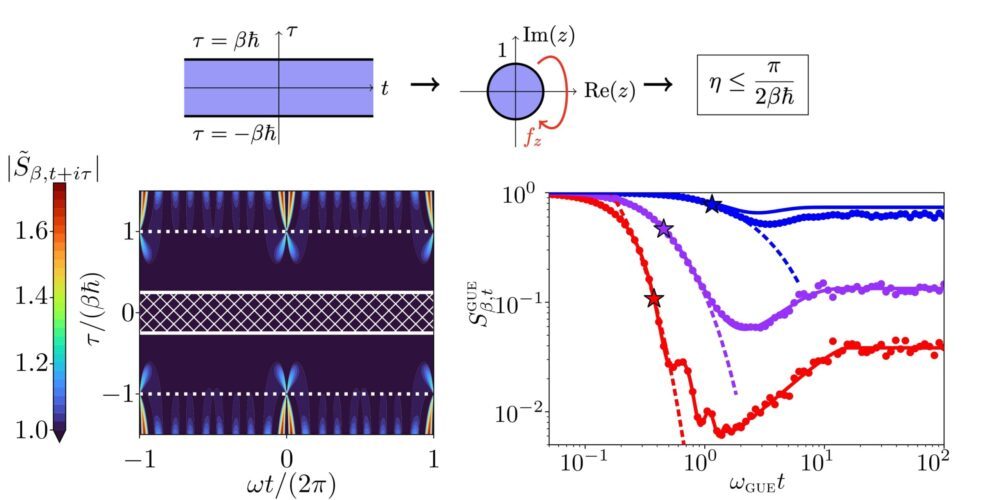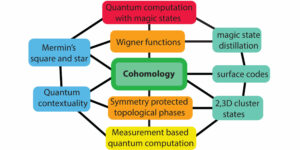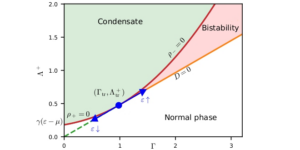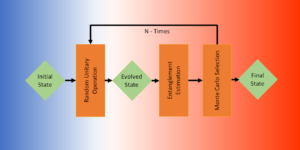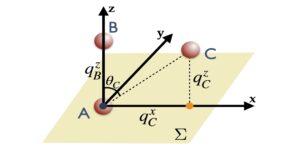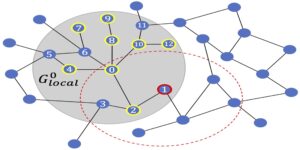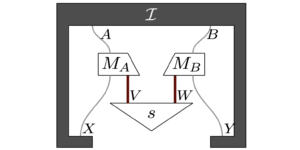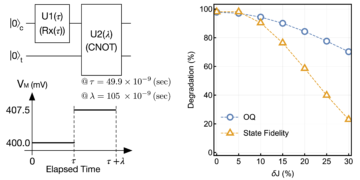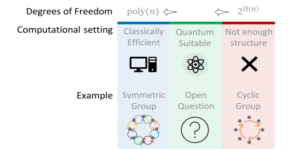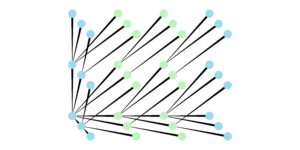Département de physique et science des matériaux, Université du Luxembourg, L-1511 Luxembourg
Vous trouvez cet article intéressant ou souhaitez en discuter? Scite ou laisse un commentaire sur SciRate.
Abstract
Le chaos quantique ne peut pas se développer plus vite que $lambda leq 2 pi/(hbar beta)$ pour les systèmes en équilibre thermique [Maldacena, Shenker & Stanford, JHEP (2016)]. Cette `MSS borne' sur l'exposant de Lyapunov $lambda$ est fixée par la largeur de la bande sur laquelle le corrélateur hors-temps régularisé est analytique. Nous montrons que des contraintes similaires limitent également la décroissance du facteur de forme spectrale (SFF), qui mesure la corrélation spectrale et est défini à partir de la transformée de Fourier de la fonction de corrélation à deux niveaux. Plus précisément, le $textit{exposant d'inflexion}$ $eta$, que nous introduisons pour caractériser la décroissance précoce du SFF, est borné par $etaleq pi/(2hbarbeta)$. Cette borne est universelle et existe en dehors du régime chaotique. Les résultats sont illustrés dans des systèmes à dynamique régulière, chaotique et accordable, à savoir l'oscillateur harmonique à une seule particule, le modèle de Calogero-Sutherland à plusieurs particules, un ensemble de la théorie des matrices aléatoires et le quantum kicked top. La relation de la borne dérivée avec d'autres bornes connues, y compris les limites de vitesse quantiques, est discutée.
Image en vedette : Illustration de la preuve de la borne (en haut), renormalisation de la bande pour l'exposant d'inflexion extensive (en bas à gauche) et le facteur de forme spectrale avec sa décroissance exponentielle (en bas à droite)
[Contenu intégré]
Résumé populaire
En utilisant des outils d'analyse complexe, nous trouvons une limite similaire sur la décroissance initiale d'une quantité appelée facteur de forme spectrale (SFF), qui est définie à partir de la fonction de partition du système à des températures complexes. Plus le système est chaud, plus la décroissance précoce du SFF peut être rapide. Cette borne est universelle et non restreinte aux dynamiques chaotiques. Nous illustrons les résultats dans des systèmes conceptuellement très différents et discutons des liens entre d'autres limites connues, telles que les limites de vitesse quantique.
► Données BibTeX
► Références
L. Mandelstam et I. Tamm, dans Selected Papers, édité par IE Tamm, BM Bolotovskii, VY Frenkel et R. Peierls (Springer, Berlin, Heidelberg, 1991) pp. 115–123.
https://doi.org/10.1007/978-3-642-74626-0_8
N. Margolus et LB Levitin, Physica D: Actes des phénomènes non linéaires du quatrième atelier sur la physique et la consommation, 120, 188 (1998).
https://doi.org/10.1016/S0167-2789(98)00054-2
LB Levitin et T. Toffoli, Phys. Rév. Lett. 103, 160502 (2009).
https: / / doi.org/ 10.1103 / PhysRevLett.103.160502
A. del Campo, IL Egusquiza, MB Plenio et SF Huelga, Phys. Rev. Lett. 110, 050403 (2013).
https: / / doi.org/ 10.1103 / PhysRevLett.110.050403
MM Taddei, BM Escher, L. Davidovich et RL de Matos Filho, Phys. Rev. Lett. 110, 050402 (2013).
https: / / doi.org/ 10.1103 / PhysRevLett.110.050402
P. Pfeifer et J. Fröhlich, Rev. Mod. Phys. 67, 759 (1995).
https: / / doi.org/ 10.1103 / RevModPhys.67.759
G. Muga, RS Mayato et I. Egusquiza, eds., Time in Quantum Mechanics, 2e éd., Lecture Notes in Physics (Springer-Verlag, Berlin Heidelberg, 2008).
https: / / www.springer.com/ gp / book / 9783540734727
G. Muga, A. Ruschhaupt et A. Campo, Time in Quantum Mechanics-Vol. 2, Vol. 789 (2009).
https://link.springer.com/book/10.1007/978-3-642-03174-8
M. Frey, Quantum Inf Process 15, 3919 (2016).
https: / / doi.org/ 10.1007 / s11128-016-1405-x
S. Deffner et S. Campbell, J. Phys. R: Mathématiques. Theor. 50, 453001 (2017).
https://doi.org/10.1088/1751-8121/aa86c6
B. Shanahan, A. Chenu, N. Margolus et A. del Campo, Phys. Rév. Lett. 120, 070401 (2018).
https: / / doi.org/ 10.1103 / PhysRevLett.120.070401
M. Okuyama et M. Ohzeki, Phys. Rév. Lett. 120, 070402 (2018).
https: / / doi.org/ 10.1103 / PhysRevLett.120.070402
PM Poggi, S. Campbell et S. Deffner, PRX Quantum 2, 040349 (2021).
https: / / doi.org/ 10.1103 / PRXQuantum.2.040349
LP García-Pintos, SB Nicholson, JR Green, A. del Campo et AV Gorshkov, Physical Review X 12, 011038 (2022).
https: / / doi.org/ 10.1103 / PhysRevX.12.011038
JD Bekenstein, Phys. Rév. Lett. 46, 623 (1981).
https: / / doi.org/ 10.1103 / PhysRevLett.46.623
S. Lloyd, Nature 406, 1047 (2000).
https: / / doi.org/ 10.1038 / 35023282
A. del Campo, J. Molina-Vilaplana et J. Sonner, Phys. Rév. D 95, 126008 (2017).
https: / / doi.org/ 10.1103 / PhysRevD.95.126008
M. Bukov, D. Sels et A. Polkovnikov, Examen physique X 9, 011034 (2019).
https: / / doi.org/ 10.1103 / PhysRevX.9.011034
T. Fogarty, S. Deffner, T. Busch et S. Campbell, Lettres d'examen physique 124, 110601 (2020).
https: / / doi.org/ 10.1103 / PhysRevLett.124.110601
A. del Campo, Lettres d'examen physique 126, 180603 (2021).
https: / / doi.org/ 10.1103 / PhysRevLett.126.180603
T. Caneva, M. Murphy, T. Calarco, R. Fazio, S. Montangero, V. Giovannetti et GE Santoro, Phys. Rév. Lett. 103, 240501 (2009).
https: / / doi.org/ 10.1103 / PhysRevLett.103.240501
K. Funo, J.-N. Zhang, C. Chatou, K. Kim, M. Ueda et A. del Campo, Phys. Rev. Lett. 118, 100602 (2017).
https: / / doi.org/ 10.1103 / PhysRevLett.118.100602
V. Giovannetti, S. Lloyd et L. Maccone, Nature Photon 5, 222 (2011).
https: / / doi.org/ 10.1038 / nphoton.2011.35
M. Beau et A. del Campo, Physical Review Letters 119, 010403 (2017).
https: / / doi.org/ 10.1103 / PhysRevLett.119.010403
J. Maldacena, SH Shenker et D. Stanford, J. High Energ. Phys. 2016, 106 (2016).
https: / / doi.org/ 10.1007 / JHEP08 (2016) 106
AI Larkin et YN Ovchinnikov, Journal soviétique de physique expérimentale et théorique 28, 1200 (1969).
http:///adsabs.harvard.edu/abs/1969JETP…28.1200L
K. Hashimoto, K. Murata et R. Yoshii, J. High Energy Phys. 2017, 138 (2017).
https: / / doi.org/ 10.1007 / JHEP10 (2017) 138
M. Hanada, H. Shimada et M. Tezuka, Phys. Rév. E 97, 022224 (2018).
https: / / doi.org/ 10.1103 / PhysRevE.97.022224
H. Gharibyan, M. Hanada, B. Swingle et M. Tezuka, J. High Energy Phys. 2019, 82 (2019).
https: / / doi.org/ 10.1007 / JHEP04 (2019) 082
T. Akutagawa, K. Hashimoto, T. Sasaki et R. Watanabe, J. High Energy Phys. 2020, 13 (2020).
https: / / doi.org/ 10.1007 / JHEP08 (2020) 013
B. Kobrin, Z. Yang, GD Kahanamoku-Meyer, CT Olund, JE Moore, D. Stanford et NY Yao, Phys. Rév. Lett. 126, 030602 (2021).
https: / / doi.org/ 10.1103 / PhysRevLett.126.030602
EB Rozenbaum, S. Ganeshan et V. Galitski, Phys. Rév. Lett. 118, 086801 (2017).
https: / / doi.org/ 10.1103 / PhysRevLett.118.086801
H. Shen, P. Zhang, R. Fan et H. Zhai, Phys. Rév. B 96, 054503 (2017).
https: / / doi.org/ 10.1103 / PhysRevB.96.054503
N. Tsuji, T. Shitara et M. Ueda, Phys. Rév. E 97, 012101 (2018a).
https: / / doi.org/ 10.1103 / PhysRevE.97.012101
LM Sieberer, T. Olsacher, A. Elben, M. Heyl, P. Hauke, F. Haake et P. Zoller, npj Quantum Inf 5, 1 (2019).
https://doi.org/10.1038/s41534-019-0192-5
EM Fortes, I. García-Mata, RA Jalabert et DA Wisniacki, Phys Rev E 100, 042201 (2019).
https: / / doi.org/ 10.1103 / PhysRevE.100.042201
J. Chávez-Carlos, B. López-del Carpio, MA Bastarrachea-Magnani, P. Stránský, S. Lerma-Hernández, LF Santos et JG Hirsch, Phys. Rév. Lett. 122, 024101 (2019).
https: / / doi.org/ 10.1103 / PhysRevLett.122.024101
A. Keles, E. Zhao et WV Liu, Phys. Rév. A 99, 053620 (2019).
https: / / doi.org/ 10.1103 / PhysRevA.99.053620
RJ Lewis-Swan, A. Safavi-Naini, JJ Bollinger et AM Rey, Nat. Commun. 10, 1581 (2019).
https: / / doi.org/ 10.1038 / s41467-019-09436-y
S. PG, V. Madhok et A. Lakshminarayan, J. Phys. D : Appl. Phys. 54, 274004 (2021).
https://doi.org/10.1088/1361-6463/abf8f3
S. Pilatowsky-Cameo, J. Chávez-Carlos, MA Bastarrachea-Magnani, P. Stránský, S. Lerma-Hernández, LF Santos et JG Hirsch, Phys. Rév. E 101, 010202 (2020).
https: / / doi.org/ 10.1103 / PhysRevE.101.010202
Z. Wang, J. Feng et B. Wu, Phys. Rev.Recherche 3, 033239 (2021).
https: / / doi.org/ 10.1103 / PhysRevResearch.3.033239
C. Yin et A. Lucas, Phys. Rév. A 103, 042414 (2021).
https: / / doi.org/ 10.1103 / PhysRevA.103.042414
A. Kitaev, « Hidden Correlations in the Hawking Radiation and Thermal Noise », (2014), conférence donnée au Fundamental Physics Prize Symposium.
https:///online.kitp.ucsb.edu/online/joint98/kitaev/rm/jwvideo.html
J. Kurchan, J. Stat. Phys. 171, 965 (2018).
https://doi.org/10.1007/s10955-018-2052-7
N. Tsuji, T. Shitara et M. Ueda, Phys. Rév. E 98, 012216 (2018b).
https: / / doi.org/ 10.1103 / PhysRevE.98.012216
GJ Turiaci, J. Physique des hautes énergies. 2019, 99 (2019).
https: / / doi.org/ 10.1007 / JHEP07 (2019) 099
C. Murthy et M. Srednicki, Phys. Rév. Lett. 123, 230606 (2019).
https: / / doi.org/ 10.1103 / PhysRevLett.123.230606
S. Kundu, J. High Energ. Phys. 2022, 10 (2022).
https: / / doi.org/ 10.1007 / JHEP04 (2022) 010
S. Pappalardi et J. Kurchan, SciPost Physics 13, 006 (2022).
https: / / doi.org/ 10.21468 / SciPostPhys.13.1.006
S. Pappalardi, L. Foini et J. Kurchan, SciPost Physics 12, 130 (2022).
https: / / doi.org/ 10.21468 / SciPostPhys.12.4.130
S. Grozdanov, Phys. Rév. Lett. 126, 051601 (2021a), éditeur : American Physical Society.
https: / / doi.org/ 10.1103 / PhysRevLett.126.051601
M. Heyl, A. Polkovnikov et S. Kehrein, Phys. Rév. Lett. 110, 135704 (2013), éditeur : American Physical Society.
https: / / doi.org/ 10.1103 / PhysRevLett.110.135704
JLF Barbón et E. Rabinovici, J. High Energy Phys. 2003, 047 (2003).
https://doi.org/10.1088/1126-6708/2003/11/047
J. Barbón et E. Rabinovici, Fortschritte der Physik 52, 642 (2004).
https: / / doi.org/ 10.1002 / prop.200410157
K. Papadodimas et S. Raju, Phys. Rév. Lett. 115, 211601 (2015).
https: / / doi.org/ 10.1103 / PhysRevLett.115.211601
JS Cotler, G. Gur-Ari, M. Hanada, J. Polchinski, P. Saad, SH Shenker, D. Stanford, A. Streicher et M. Tezuka, J. High Energ. Phys. 2017, 118 (2017a).
https: / / doi.org/ 10.1007 / JHEP05 (2017) 118
J. Cotler, N. Hunter-Jones, J. Liu et B. Yoshida, J. High Energy Phys. 2017, 48 (2017b).
https: / / doi.org/ 10.1007 / JHEP11 (2017) 048
ML Mehta, Matrices aléatoires (Elsevier/Academic Press, 2004).
https://www.elsevier.com/books/random-matrices/lal-mehta/978-0-12-088409-4
F. Haake, M. Kuś et R. Scharf, Z. Physik B – Condensed Matter 65, 381 (1987).
https: / / doi.org/ 10.1007 / BF01303727
B. Bertini, P. Kos et T. Prosen, Lettres d'examen physique 121, 264101 (2018).
https: / / doi.org/ 10.1103 / PhysRevLett.121.264101
Z. Xu, LP García-Pintos, A. Chenu et A. del Campo, Phys. Rév. Lett. 122, 014103 (2019).
https: / / doi.org/ 10.1103 / PhysRevLett.122.014103
A. del Campo et T. Takayanagi, J. High Energy Phys. 2020, 170 (2020).
https: / / doi.org/ 10.1007 / JHEP02 (2020) 170
Z. Xu, A. Chenu, T. Prosen et A. del Campo, Phys. Rév. B 103, 064309 (2021).
https: / / doi.org/ 10.1103 / PhysRevB.103.064309
J. Cornelius, Z. Xu, A. Saxena, A. Chenu et A. del Campo, Phys. Rév. Lett. 128, 190402 (2022).
https: / / doi.org/ 10.1103 / PhysRevLett.128.190402
RE Prange, Phys. Rév. Lett. 78, 2280 (1997).
https: / / doi.org/ 10.1103 / PhysRevLett.78.2280
F. Calogero, Journal of Mathematical Physics 12, 419 (2003), éditeur : American Institute of PhysicsAIP.
https: / / doi.org/ 10.1063 / 1.1665604
B. Sutherland, J. Math. Phys. 12, 246 (1971), éditeur : American Institute of Physics.
https: / / doi.org/ 10.1063 / 1.1665584
P. Claus, M. Derix, R. Kallosh, J. Kumar, PK Townsend et A. Van Proeyen, Phys. Rév. Lett. 81, 4553 (1998), éditeur : American Physical Society.
https: / / doi.org/ 10.1103 / PhysRevLett.81.4553
GW Gibbons et PK Townsend, Physics Letters B 454, 187 (1999).
https://doi.org/10.1016/S0370-2693(99)00266-X
O. Lechtenfeld et S. Nampuri, Physics Letters B 753, 263 (2016).
https: / / doi.org/ 10.1016 / j.physletb.2015.11.083
FDM Haldane, Phys. Rév. Lett. 67, 937 (1991), éditeur : American Physical Society.
https: / / doi.org/ 10.1103 / PhysRevLett.67.937
Y.-S. Wu, Ph. Rév. Lett. 73, 922 (1994), éditeur : American Physical Society.
https: / / doi.org/ 10.1103 / PhysRevLett.73.922
MVN Murthy et R. Shankar, Phys. Rév. Lett. 73, 3331 (1994), éditeur : American Physical Society.
https: / / doi.org/ 10.1103 / PhysRevLett.73.3331
J. Jaramillo, M. Beau et A. d. Campo, New J. Phys. 18, 075019 (2016), éditeur : IOP Publishing.
https://doi.org/10.1088/1367-2630/18/7/075019
Publicité. Campo, New J. Phys. 18, 015014 (2016), éditeur : IOP Publishing.
https://doi.org/10.1088/1367-2630/18/1/015014
EP Wigner, Actes mathématiques de la Cambridge Philosophical Society 47, 790 (1951).
https: / / doi.org/ 10.1017 / S0305004100027237
EP Wigner, dans Conference on neutron physics by time-of-flight (1956) pp. 1–2.
A. Chenu, IL Egusquiza, J. Molina-Vilaplana et A. del Campo, Sci. Rep. 8, 12634 (2018).
https: / / doi.org/ 10.1038 / s41598-018-30982-w
A. Chenu, J. Molina-Vilaplana et A. del Campo, Quantum 3, 127 (2019).
https://doi.org/10.22331/q-2019-03-04-127
O. Bohigas, MJ Giannoni et C. Schmit, Phys. Rév. Lett. 52, 1 (1984a).
https: / / doi.org/ 10.1103 / PhysRevLett.52.1
O. Bohigas, MJ Giannoni et C. Schmit, J. Physique Lett. 45, 1015 (1984b).
https:///doi.org/10.1051/jphyslet:0198400450210101500
M. Kuś, R. Scharf et F. Haake, Z. Physik B – Condensed Matter 66, 129 (1987).
https: / / doi.org/ 10.1007 / BF01312770
R. Scharf, B. Dietz, M. Kuś, F. Haake et MV Berry, EPL 5, 383 (1988).
https://doi.org/10.1209/0295-5075/5/5/001
F. Haake et DL Shepelyansky, EPL 5, 671 (1988).
https://doi.org/10.1209/0295-5075/5/8/001
RF Fox et TC Elston, Phys. Rev. E 50, 2553 (1994).
https: / / doi.org/ 10.1103 / PhysRevE.50.2553
S. Chaudhury, A. Smith, BE Anderson, S. Ghose et PS Jessen, Nature 461, 768 (2009).
https: / / doi.org/ 10.1038 / nature08396
F. Haake, Signatures quantiques du chaos (Springer Berlin Heidelberg, 2010).
https://link.springer.com/book/10.1007/978-3-642-05428-0
J. Wang et J. Gong, Phys. Rév. Lett. 102, 244102 (2009).
https: / / doi.org/ 10.1103 / PhysRevLett.102.244102
J. Wang et J. Gong, Phys. Rév. E 81, 026204 (2010).
https: / / doi.org/ 10.1103 / PhysRevE.81.026204
K. Bhattacharyya, J. Phys. R : Mathématiques. 16 général, 2993 (1983).
https://doi.org/10.1088/0305-4470/16/13/021
SA Hartnoll et AP Mackenzie, « Planckian Dissipation in Metals », (2022), arXiv:2107.07802 [cond-mat, physics:hep-th].
https:///doi.org/10.48550/arXiv.2107.07802
arXiv: 2107.07802
S. Grozdanov, Lettres d'examen physique 126, 051601 (2021b).
https: / / doi.org/ 10.1103 / PhysRevLett.126.051601
Cité par
Impossible de récupérer Données de référence croisée lors de la dernière tentative 2022-11-03 18:29:27: Impossible de récupérer les données citées par 10.22331 / q-2022-11-03-852 de Crossref. C'est normal si le DOI a été enregistré récemment. Sur SAO / NASA ADS aucune donnée sur la citation des œuvres n'a été trouvée (dernière tentative 2022-11-03 18:29:27).
Cet article est publié dans Quantum sous le Creative Commons Attribution 4.0 International (CC BY 4.0) Licence. Le droit d'auteur reste la propriété des détenteurs d'origine tels que les auteurs ou leurs institutions.

